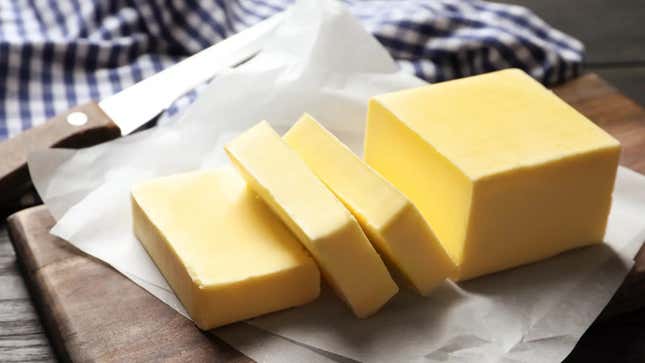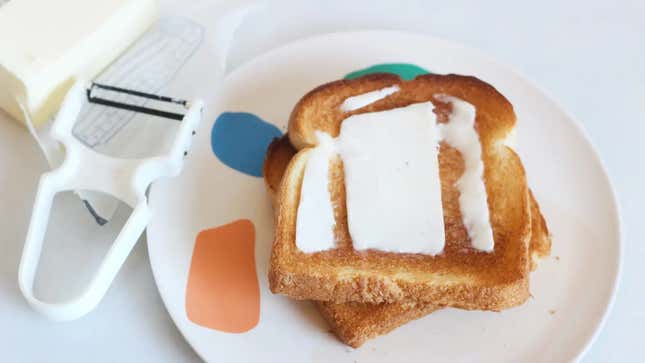
Every time I eat something with butter on it, I’m lightly amazed at what an incredible product it is. Butter tastes so good, and the only problem it ever gives me is being too cold (like my ex) or too hard (like...not my ex).
Recipes that call for melted butter are easy; it’s the ones that needsoftened or room-temperature butter that can mess you up and delay your baking projects. Here are three easy ways to soften butter, and when you should use each.
Peel or grate cold butter for toast

The nice thing about toast is that it’s hotenough to melt a thin sheet or finely grated pile of butter. I like totake a vegetable peeler to mine, and peel the top layer off the cold block. Then I put it on toast and watch it melt.
If you don’t have a vegetable peeler,a box grater worksjust as well. Just grab the butter chunk and grate until you have “enough,” then put the little bits on your toast and smear it around. You can also use shredded butter in baked goods that call for softened butter—just shred the required amount and toss it in.
打冷黄油屈服
Forsomebaking projects, it’s enough for the butter to be merely softened, but still cold. As A.A. Newtonhas explained, it depends on what you’re adding it to:
But incorporating cold butter into softer, squishier substances—like brioche dough, cream cheese, or meringue—doesn’t work at all. You’ll end up with tiny globs of hard butter that no amount of mixing will disperse.
The basic rule of thumb: If a recipe starts with butter and sugar, cold is perfectly fine—just be sure to beat the butter by itself for a bit to warm it up. If you’re adding butter to something else, it absolutely must be room temperature. That doesn’t have to throw a wrench in your baking schedule, though.
If you’re starting off by creaming butter and sugar together, just beat the heck out of itusing your stand mixer, hand mixer, ora rolling pin and plastic bag.
Give it a little heat ortime
Here’s the thing: Provided your kitchen isn’t completely freezing, cutting a stick of butter into small chunks and setting it out on the counter for half an hour will do the trick. If you really can’t wait 30 minutes, consider microwaving it for five seconds at a time, flipping it onto the next side after every burst until it’s soft androom temp.
I don’t care for that glass trick
There’sa popular butter-softening hackthat involves filling a glass with hot water, then dumping out the water, drying the glass, and inverting the glass over the butter. It works, but not any better or faster than the microwave, especially ifyour tap water doesn’t getthathot. To use this hack, I had to boil some water first, and it took the hot glass a whole seven minutes to soften the stick, which is far more time than it takes to pop it in the microwave as described above.
What to do whenyou gotoofar
Buttersofteningcan turn to buttermeltingreal quick, especially if you’re not familiar with your microwave or its power settings. Trying to use melted butter in a recipe that calls for softened will result in a greasy mess, but fret not, you can “fix” your butter with一个simple ice bath:
The tip is pretty simple actually: just grab a small bowl, add a few ice cubes, and add the butter soup to the ice directly. Stir it up a bit and the immediate chill will firm the butter back up to the point where you can use a spoon or spatula to get it back out of the bowl, all before the ice melts (and adds water to the mix.) When tested, the ATK team noted that the butter was just as good when used for baking, so the next time you leave the butter out just a little too long or decide tomicrowave it for just a few seconds, this tip may save the day.
